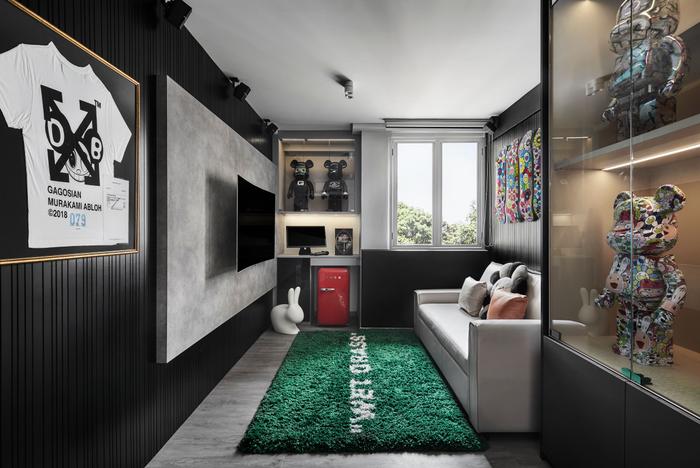For karaoke nights and conducive online meetings.
Whether you’re hosting late-night karaoke sessions, binge-watching movies with the volume up, or sitting through virtual meetings at home, one thing’s for sure — good soundproofing can go a long way. Not only does it make your space more comfortable, but it also keeps the peace (to avoid noise complaints from neighbours or waking your young kids napping in the other room).

And it’s not just about keeping noise out. Soundproofing can improve acoustics inside the room too, making your Netflix marathons and gaming setups sound crisper and clearer.
We cover some practical ways to soundproof your home in this guide – so read on if an entertainment room or home office is in the books for your upcoming renovation!
1. Changing the layout of your home (with soundproofing in mind)
One of the most underrated but effective ways to soundproof your home starts with the layout.

View this project by Fifth Avenue Interior
In this Punggol HDB makeover, the homeowners completely reimagined their 5-room flat’s floor plan to prioritise privacy and quiet. Instead of sticking to the original room divisions, they opted for a hotel-style suite layout with a large master bedroom, walk-in wardrobe, and an enclosed workspace — strategically zoned away from the living and entertainment areas.

Pre-renovation floorplan of the 5-room HDB flat

Post-renovation floorplan of the 5-room HDB flat; living area and master bedroom act as physical buffers between karaoke room (circled) and the neighbours.
This kind of separation isn’t just for aesthetics; it helps contain noise where it matters. Having clearly defined zones — such as keeping common areas like the living room or kitchen on one side of the home, and quiet zones like bedrooms or study rooms on the other — can reduce sound transmission significantly.
If you’re renovating from scratch, consider placing your entertainment room or WFH space further from the entrance or shared walls. Even simple tweaks, like shifting your TV wall or designing a buffer zone with walk-in wardrobes or storage corridors, can add an extra layer of acoustic insulation — no hacking required.
2. Hang thick and heavy curtains to block out sound
It’s not just about blocking sunlight — curtains can also play a big role in keeping sound out (or in). Thick, heavyweight curtains made of dense materials like velvet, polyester, or specially designed acoustic fabrics can help absorb noise and reduce echo, especially in rooms with large windows or hard surfaces.

View this project by Four By Eight Design Studio
If your home faces a busy road or noisy neighbours, hanging full-length blackout or soundproof/acoustic curtains over your windows can dampen outdoor sounds. And for entertainment rooms or home offices, layering curtains over glass partitions is a simple, rental-friendly way to add privacy and muffle noise.
Pro tip: The more fabric, the better. Go for floor-to-ceiling curtains that extend beyond the window frame for maximum coverage — and acoustic impact.
3. Insulate the floor with multiple layers
When it comes to soundproofing, the floor is often overlooked — but it plays a big part, especially in multi-storey homes or apartments. Hard flooring materials like tiles or vinyl can amplify footsteps, bass, and vibrations, so adding layers underneath can help absorb impact and reduce noise transfer between levels.

View this project by Fifth Avenue Interior
In this home’s karaoke room, the floor was built up with multiple layers — including cement screed, plywood, and vinyl flooring — to buffer both outgoing and incoming sounds. This approach creates a denser, more sound-absorbent base, which is especially useful in spaces meant for high-volume entertainment.
Even if you're not renovating, adding thick rugs, carpet tiles, or underlay padding beneath your flooring can also help to insulate sound. It’s a worthwhile step for anyone looking to keep the peace or the party going — without disturbing the neighbours.
4. Embedding rockwool within ceilings and walls
For serious soundproofing, you’ll want to go beyond surface treatments — and that’s where materials like rockwool come in. Commonly used for insulation, rockwool is excellent at absorbing airborne sound and dampening noise transmission through walls, ceilings, and even floors.

View this project by Style Elements Studio
In this Tampines executive apartment, the homeowners transformed one of the bedrooms into a dedicated entertainment room. To keep movie nights and late-night gaming from disturbing the rest of the household, they embedded rockwool insulation within both the false ceiling and walls. Although this made the walls thicker and reduced available space in the room, it helped to minimise echo within the room and reduce noise leakage outside it.
If you're building a media room or home office, installing rockwool behind drywall or within a false ceiling is a sound investment — quite literally. Just be sure to pair it with other soundproofing strategies in this list for best results.
5. Install acoustic panels to absorb sound
For those thinking of setting up a music studio at home, podcasting corner, or entertainment zone, installing acoustic panels can go a long way in improving the sound quality within the space — while also keeping noise from leaking out.

View this project by Urban Home Design 二本設計家
These foam or fabric-wrapped panels are designed to absorb mid to high-frequency sounds, helping to reduce echo and reverberation. In the room shown above, acoustic panels have been mounted on the walls and ceiling to create a more acoustically controlled environment — ideal for recording or critical listening.
They’re also relatively easy to install and customisable in terms of size, colour, and placement. Whether mounted permanently or placed on freestanding frames, acoustic panels are a practical, non-invasive way to enhance both soundproofing and sound clarity at home.
6. Use acoustic or double-glazed glass partitions

View this project by Gentlemen Crafts
Glass partitions might not be the first thing that comes to mind when thinking about soundproofing — but with the right type, they can be both stylish and functional. Acoustic or double-glazed glass partitions feature two or more layers of glass with an insulating air or gas layer in between, helping to significantly reduce noise transmission between spaces.

View this project by Aart Boxx Interior
They’re perfect for homeowners who want to create visual openness while still maintaining a level of sound control — especially in work-from-home setups or entertainment rooms. Whether used as full-height dividers or sliding doors, these glass panels help keep noise contained without sacrificing light or style.
Just be sure to pair them with proper sealing around the edges to prevent sound leaks — and opt for thicker glass if you're aiming for maximum sound insulation.
7. Build tall bookshelves to create a barrier against sound transfer
Sometimes, the simplest solutions are the most effective — and in the case of soundproofing, built-in bookshelves can pull double duty. When lined with books or decorative items, tall shelves act as a dense barrier that helps absorb and block sound from passing through shared walls.

View this project by ANSANA
They’re especially useful in flats where your unit shares a wall with neighbours, or where a room backs onto a noisy corridor. Plus, unlike traditional soundproofing methods, bookshelves don’t require major renovation works and can be customised to match your home’s style.
For best results, go for floor-to-ceiling designs and fill the shelves with a mix of soft and dense materials — like paperbacks, fabric-covered boxes, or even acoustic foam hidden behind books. You’ll get a quieter space and more storage — win-win.
Building your dream entertainment room?
Click on the button below to tell us your renovation requirements, and we will get you renovation quotes from local interior design firms – free of charge!

 Get a budget estimate before meeting IDs
Get a budget estimate before meeting IDs